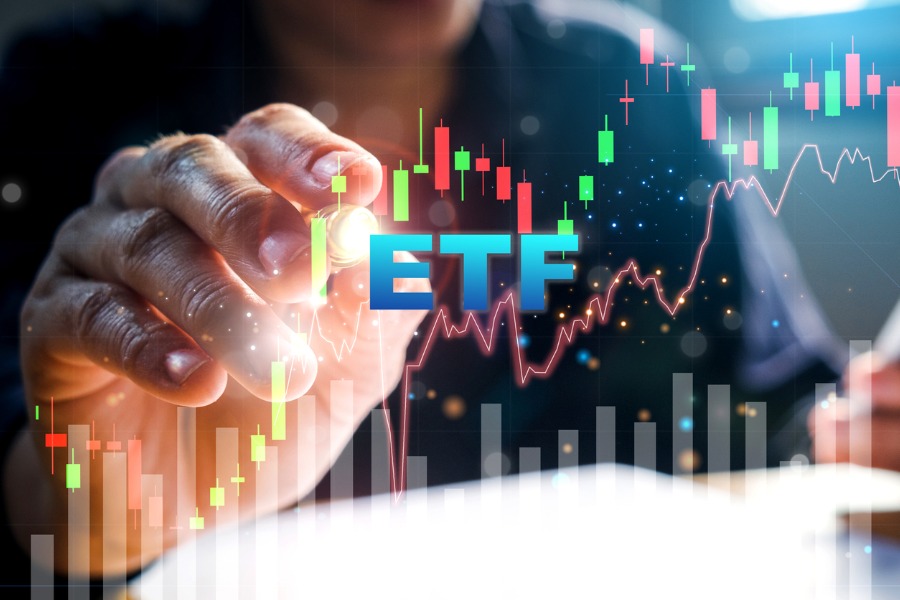

US-listed exchange-traded funds took in a record $296 billion in the first quarter of 2025, surpassing the previous first-quarter high of $248 billion set in 2021, according to the latest ETF Flash Flows report from State Street Global Advisors.
March alone saw $96 billion in inflows, marking the ninth-strongest month for ETF flows in history.
Beneath the record headline, however, investor sentiment is clearly turning cautious. With a murky macroeconomic outlook and rising geopolitical risk, flows reveal a shift toward defensive and inflation-sensitive strategies. The ongoing trade tensions and tariff threats coming from the Trump administration, combined with weakening US growth projections and stubborn inflation expectations, have stoked renewed portfolio positioning.
Gold funds led the defensive charge, pulling in $6.2 billion in March. That follows February’s $6.6 billion, putting first-quarter gold ETF flows at $12 billion, the highest since the pandemic-driven volatility of 2020. These inflows, paired with market appreciation, helped push total assets in commodity ETFs above $200 billion for the first time ever.
Meanwhile, bond ETFs continued to attract strong demand, with $22 billion of inflows in March. Investors favored the short end of the curve, steering $7 billion into ultrashort government bond funds and $1.8 billion into inflation-protected bond ETFs. In total, fixed income ETFs brought in $100 billion for the quarter, putting them on track for a record-setting $400 billion year.
"[T]wo buying behavior tactical trends emerged beneath the surface in March: the desire to position defensively amid macro confusion and for an environment where inflation may be more stubborn than previously thought," wrote Matthew Bartolini, head of Americas ETF research, at SSGA.
That caution is backed by recent performance data. US equities fell nearly 6 percent in March, with more than 70 percent of S&P 500 stocks finishing in negative territory. Corporate earnings expectations have been revised lower across every sector, and consumer sentiment has dropped to its lowest point since 2022.
Value ETFs are showing new signs of life, reflecting a broader market rotation. In March, value strategies attracted $9.6 billion, as they outperformed growth by three percentage points. The shift could signal a longer-term pivot away from growth-heavy exposures amid a less favorable macro backdrop.
Another standout trend is the continued growth of active ETFs, which pulled in $120 billion in the first quarter, accounting for 40 percent of all ETF flows. That puts active strategies on pace to exceed $500 billion in annual flows, nearly half of their current $1 trillion asset base.
Not every segment benefited from the inflow surge. Sector ETFs saw $3 billion in outflows in March, dragged down by cyclical segments such as consumer discretionary, which shed $2.2 billion, and energy, which lost $1 billion. In total, seven out of 11 sectors saw net outflows for the month.
As the Federal Reserve holds firm on policy and global volatility persists, many advisors appear to be rebalancing portfolios with a greater emphasis on resilience, diversification and income stability – shifting from risk-on plays to strategies built for turbulence.

While industry statistics pointing to a succession crisis can cause alarm, advisor-owners should be free to consider a middle path between staying solo and catching the surging wave of M&A.

New joint research by T. Rowe Price, MIT, and Stanford University finds more diverse asset allocations among older participants.

With its asset pipeline bursting past $13 billion, Farther is looking to build more momentum with three new managing directors.

A Department of Labor proposal to scrap a regulatory provision under ERISA could create uncertainty for fiduciaries, the trade association argues.

"We continue to feel confident about our ability to capture 90%," LPL CEO Rich Steinmeier told analysts during the firm's 2nd quarter earnings call.
Orion's Tom Wilson on delivering coordinated, high-touch service in a world where returns alone no longer set you apart.
Barely a decade old, registered index-linked annuities have quickly surged in popularity, thanks to their unique blend of protection and growth potential—an appealing option for investors looking to chart a steadier course through today's choppy market waters, says Myles Lambert, Brighthouse Financial.
